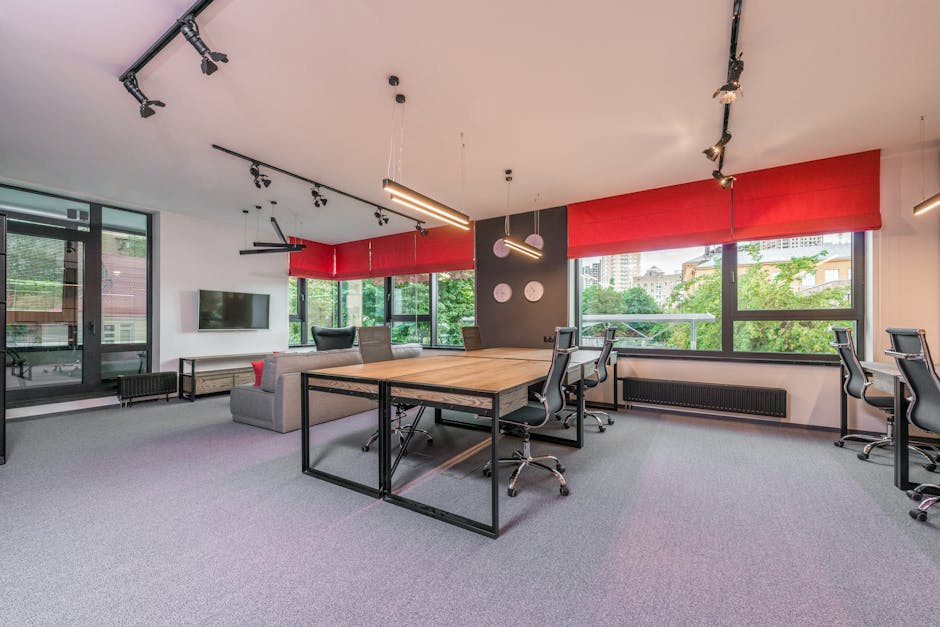Creating a Wellness-Centered Workplace: 7 Health-Focused Office Design Ideas
“In today's competitive business landscape, organizations are recognizing that employee wellness directly impacts productivity and retention. This article explores practical design strategies to create health-centered workspaces that support physical and mental wellbeing, from activity-based working principles to biophilic elements that reduce stress and enhance workplace satisfaction. ”

Creating a Wellness-Centered Workplace: 7 Health-Focused Office Design Ideas
In today's evolving workplace landscape, employee health and wellness have moved from nice-to-have perks to essential components of successful business strategy. Research consistently shows that investing in workplace wellness yields significant returns—with every $1 invested in mental health promotion generating a $3 to $5 return through reduced absenteeism and increased productivity.
For HR managers, facility directors, and workplace strategists, implementing health-focused design elements isn't just about creating beautiful spaces—it's about fostering environments where employees can thrive physically, emotionally, and mentally.

Why Workplace Wellness Matters
The traditional open office layout, once heralded as the pinnacle of collaborative design, has increasingly come under scrutiny for its negative impacts on employee wellbeing. Excessive noise, constant distractions, and lack of privacy contribute to stress, reduced focus, and ultimately, diminished productivity.
Forward-thinking organizations are now reimagining their workspaces with employee wellness at the center. While complete office redesigns aren't always feasible, strategic improvements can dramatically enhance workplace experience and employee satisfaction.
7 Health and Wellness Office Design Strategies
1. Embrace Activity-Based Working Principles
The open office isn't disappearing, but it is evolving. Activity-based working (ABW) addresses many psychological challenges of traditional layouts by offering employees a variety of workspace options tailored to different tasks and working styles.
By implementing ABW principles, organizations provide employees autonomy to choose environments that best suit their current needs—whether that's a quiet focus pod for concentrated work, a collaborative lounge for team brainstorming, or a standing desk for improved ergonomics.
This flexibility empowers employees to work in ways that optimize their productivity while respecting individual preferences, significantly reducing workplace anxiety and enhancing satisfaction.
2. Prioritize Natural Light and Views
Few elements impact workplace wellness as profoundly as natural light. Exposure to daylight regulates circadian rhythms, improves mood, reduces eyestrain, and boosts vitamin D production—all contributing to better overall health and productivity.
Design your office to maximize daylight penetration by:
- Positioning workstations perpendicular to windows
- Using glass partitions instead of solid walls where privacy is needed
- Ensuring all employees have access to spaces with windows
- Installing light shelves or reflective surfaces to bounce natural light deeper into the space

3. Incorporate Biophilic Design Elements
Biophilic design—connecting indoor environments with nature—has been shown to reduce stress, enhance creativity, and improve cognitive function. This approach goes beyond simply adding a few plants (though that's a great start).
Consider these biophilic strategies:
- Living walls or vertical gardens
- Natural materials like wood and stone
- Nature-inspired patterns and textures
- Water features that provide calming sounds
- Views of outdoor landscapes where possible
Research indicates that employees working in environments with natural elements report a 15% higher level of wellbeing and are 6% more productive than those in spaces without these features.
4. Create Dedicated Wellness Spaces
Designate specific areas within your office for wellness activities and rejuvenation. These spaces signal to employees that their wellbeing is valued and provide opportunities to recharge throughout the workday.
Effective wellness spaces might include:
- Quiet rooms for meditation or prayer
- Fitness areas for stretching or light exercise
- Relaxation lounges with comfortable seating
- Outdoor patios or rooftop gardens
- Nap pods for short rest periods
Even small organizations can implement scaled versions of these spaces. A quiet corner with comfortable seating and noise-canceling features can serve as an effective meditation space without requiring significant square footage.
5. Design with Ergonomics in Mind
Physical comfort is fundamental to workplace wellness. Ergonomic design reduces the risk of musculoskeletal disorders while improving focus and productivity.
Key ergonomic considerations include:
- Adjustable desks that allow for both sitting and standing
- Quality chairs with proper lumbar support
- Monitor arms for optimal screen positioning
- Keyboard trays that promote neutral wrist positions
- Footrests for shorter individuals

Encourage movement throughout the day by creating "active design" elements like centrally located staircases, walking meeting routes, and strategically placed amenities that require short walks.
6. Establish Clear Workspace Policies
Even the best-designed space can fall short without clear guidelines for usage. Well-defined policies help alleviate anxiety around shared resources and establish expectations for behavior in different areas.
Develop and communicate policies for:
- Conference room scheduling etiquette
- Noise levels in different zones
- Shared desk protocols
- Remote work guidelines
- Wellness space usage
These boundaries create psychological safety and reduce workplace stress by eliminating ambiguity around acceptable behaviors in various settings.
7. Measure and Respond to Space Utilization
Effective wellness design isn't static—it evolves based on how employees actually use the space. Implement systems to track space utilization and gather feedback about what's working and what isn't.
This data analysis allows you to:
- Identify underutilized areas that could be repurposed
- Recognize overcrowded spaces that create stress
- Understand which wellness features employees value most
- Make informed decisions about future design investments
Regular surveys, focus groups, and utilization metrics provide valuable insights that help refine your wellness-focused workplace strategy over time.
Implementing Wellness Design on Any Budget
Not every organization can undertake a complete office redesign like SINA Corporation's "Heaven for Staff" in Beijing. However, wellness-focused improvements can be implemented incrementally and at various budget levels:
Low-Cost Initiatives:
- Add indoor plants throughout the office
- Create designated quiet zones with simple signage
- Implement flexible work policies
- Rearrange furniture to maximize natural light
- Start a walking meeting program
Medium-Investment Improvements:
- Install adjustable desks in phases
- Create a small meditation or relaxation room
- Add sound-absorbing panels in noisy areas
- Improve lighting with full-spectrum bulbs
- Introduce movable privacy screens
Larger Wellness Investments:
- Redesign spaces using activity-based working principles
- Install a living wall or major biophilic elements
- Create dedicated fitness areas
- Implement comprehensive ergonomic furniture solutions
- Develop outdoor workspace options

The Business Case for Wellness-Centered Design
While the human benefits of wellness-focused workplaces are clear, the business advantages are equally compelling:
- Reduced absenteeism: Healthier employees take fewer sick days
- Improved talent attraction and retention: Wellness-centered workplaces are highly valued by job seekers
- Enhanced productivity: Comfortable, stress-reduced environments enable better focus and output
- Stronger collaboration: Thoughtfully designed spaces facilitate better teamwork
- Reduced healthcare costs: Preventative wellness measures can lower insurance expenses
Organizations that promote wellness in the workplace often see these benefits translate directly to improved financial performance and competitive advantage.
Conclusion: Creating a Culture of Wellbeing
Ultimately, the most effective wellness-centered workplaces combine thoughtful design with a genuine organizational commitment to employee health. Physical spaces should reflect and reinforce a broader culture that values wellbeing at all levels.
As you implement health and wellness office ideas, remember that the goal isn't perfection but progress—each improvement moves your workplace closer to an environment where employees can bring their best selves to work every day.
By prioritizing wellness in workplace design, organizations create spaces that don't just accommodate work but actively support the humans doing that work—resulting in healthier, happier, and more productive teams.